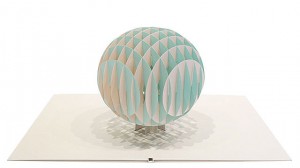Gathering together artwork made of books, artwork made for books and artist-made books themselves, The Illuminated Library, an eclectic group show at San Francisco State University’s Fine Arts Gallery, presents a longstanding relationship between printed matter and visual artists. Beginning with 13th century illuminated manuscripts and ending with drawings made in 2013, the exhibition spans time and media to showcase the many ways artists approach books, whether they serve as inspiration or end product.
The oldest work in the show is positioned closest to the gallery entrance, the automatic prelude to the rest of the more contemporary exhibition. The wall text — excellent throughout — is especially intriguing for Selected Gems from Modern Poets, a small ink on vellum book from 1942, illustrated by calligrapher and illuminator Alberto Sargorski. Encouragingly, Sargorski began his true career at age 43, working for his younger brother’s bookbinding business Sargorski & Sutcliffe. The example provided is a small taste of the firm’s most luxurious output, The Rubáiyát of Omar Khayyám, which sunk with the Titanic in 1912.
Just to the right of this display, two works by Enrique Chagoya unfold alongside 19th century reproductions of the original Codex Borgia, a Mesoamerican ritual and divinatory manuscript dating from somewhere between the 13th and 15th centuries. On first glance, I thought the entire vitrine was work by Chagoya — his accordion-fold 2011 lithograph Escape from Fantasylandia: An Illegal Alien’s Survival Guide also features a Quetzalcoatl figure in a similar cartoony style. While the pairing was momentarily confusing, the vitrine juxtaposes different levels of appropriation (cultural and critical) to a thought-provoking end.

Tauba Auerbach, [2,3], 2011
The modern books represented in the show don’t quite carry the same weight as the Great Omar, but one series manages to capture the wonder of an antique decorative bookbinding. Tauba Auerbach’s [2,3] is a series of exquisite pop-up books that open to reveal a single elaborate paper shape within the covers. Four of the six books are represented in The Illuminated Library and each is a colorful puzzle of geometric folds.




